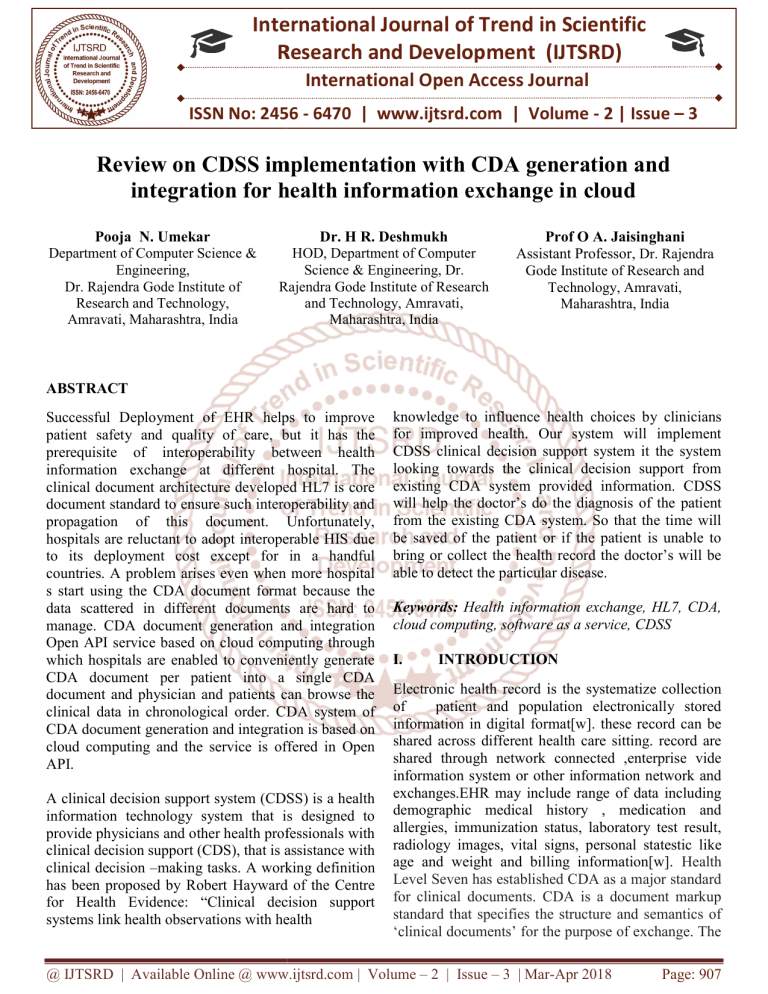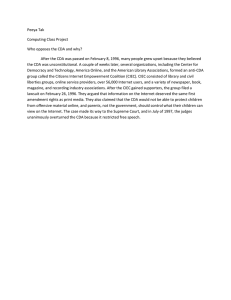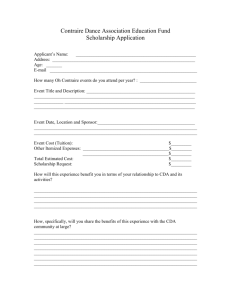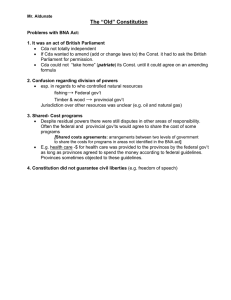
International Journal of Trend in Scientific
Research and Development (IJTSRD)
International Open Access Journal
ISSN No: 2456 - 6470 | www.ijtsrd.com | Volume - 2 | Issue – 3
Review on CDSS implementation with CDA generation and
integration for health information exchange in cloud
Pooja N. Umekar
Department of Computer Science &
Engineering,
Dr. Rajendra Gode Institute of
Research and Technology,
Amravati, Maharashtra, India
Dr. H R. Deshmukh
HOD, Department of Computer
Science & Engineering, Dr.
Rajendra Gode Institute of Research
and Technology, Amravati,
Maharashtra, India
Prof O A. Jaisinghani
Assistant Professor,
Professo Dr. Rajendra
Gode Institute of Research and
Technology,
Technology Amravati,
Maharashtra, India
ABSTRACT
Successful Deployment of EHR helps to improve
patient safety and quality of care, but it has the
prerequisite of interoperability between health
information exchange at different hospital. The
clinical document architecture developed HL7 is core
document standard to ensure such interoperability and
propagation of this document. Unfortunately,
hospitals are reluctant to adopt interoperable HIS due
to its deployment costt except for in a handful
countries. A problem arises even when more hospital
s start using the CDA document format because the
data scattered in different documents are hard to
manage. CDA document generation and integration
Open API service based on cloudd computing through
which hospitals are enabled to conveniently generate
CDA document per patient into a single CDA
document and physician and patients can browse the
clinical data in chronological order. CDA system of
CDA document generation and integrati
integration is based on
cloud computing and the service is offered in Open
API.
A clinical decision support system (CDSS) is a health
information technology system that is designed to
provide physicians and other health professionals with
clinical decision supportt (CDS), that is assistance with
clinical decision –making
making tasks. A working definition
has been proposed by Robert Hayward of the Centre
for Health Evidence: “Clinical decision support
systems link health observations with health
knowledge to influence health choices by clinicians
for improved health. Our system will implement
CDSS clinical decision support system it the system
looking towards the clinical decision support from
existing CDA system provided information. CDSS
will help the doctor’s do thee diagnosis of the patient
from the existing CDA system. So that the time will
be saved of the patient or if the patient is unable to
bring or collect the health record the doctor’s will be
able to detect the particular disease.
Keywords: Health information exchange, HL7, CDA,
cloud computing, software as a service, CDSS
I.
INTRODUCTION
Electronic health record is the systematize collection
of
patient and population electronically stored
information in digital format[w]. these record can be
shared across different health care sitting. record are
shared through network connected ,enterprise vide
information system or other information network and
exchanges.EHR may include range of data including
demographic medical history , medication and
allergies,, immunization status, laboratory test result,
radiology images, vital signs, personal statestic like
age and weight and billing information[w]. Health
Level Seven has established CDA as a major standard
for clinical documents. CDA is a document markup
standard
ndard that specifies the structure and semantics of
‘clinical documents’ for the purpose of exchange. The
@ IJTSRD | Available Online @ www.ijtsrd.com | Volume – 2 | Issue – 3 | Mar-Apr
Apr 2018
Page: 907
International Journal of Trend in Scientific Research and Development (IJTSRD) ISSN: 2456-6470
first version of CDA was developed in 2001 and
Release 2 came out in 2005 [1]. Many projects
adopting CDA have been successfully completed in
many countries. Active works are being done on
improving semantic interoperability based on open
EHR and CEN13606.
distributed in different documents. This significantly
delays the medical personnel in making decisions.
Hence, when all of the CDA documents are integrated
into a single document, the medical personnel is
empowered to review the patient’s clinical history
conveniently in chronological order.
2. Literature Review
3. PROPOSED OBJECTIVE :
Health Level Seven has established CDA as a major
standard for clinical documents [2]. CDA is a
document markup standard that specifies the structure
and semantics of ‘clinical documents’ for the purpose
of exchange. The first version of CDA was developed
in 2001 and Release 2 came out in 2005 [1]. Many
projects adopting CDA have been successfully
completed in many countries [3], [4], [5]. Active
works are being done on improving semantic
interoperability based on open EHR and CEN13606
[6], [7]. To establish confidence in HIE
interoperability, more HIS’s need to support CDA.
However, the structure of CDA is very complex and
the production of correct CDA document is hard to
achieve without deep understanding of the CDA
standard and sufficient experience with it. In addition,
development the HIS platforms for hospitals vary so
greatly that generation of CDA documents in each
hospital invariably requires a separate CDA
generation system. Also, hospitals are very reluctant
to adopt a new system unless it is absolutely
necessary for provision of care. As a result, the
adoption rate of EHR is very low except for in a few
handful countries such as New Zealand or Australia
[8]. In the USA, the government implemented an
incentive program called the Meaningful Use Program
to promote EHR adoption among hospitals [9]. When
a patient is diagnosed at a clinic, a CDA document
recording the diagnosis is generated. The CDA
document can be shared with other clinics if the
patient agrees. The concept of family doctor does not
exist in Korea, hence it is common for a patient to
visit a number of different clinics.
3.1 CDA DOCUMENT :
The exchange of CDA document is triggered in the
following cases: when a physician needs to study a
patient’s medical history; when referral and reply
letters are drafted for a patient cared by multiple
clinics; when a patient is in emergency and the
medical history needs to be reviewed. It takes
increasing amount of time for the medical personnel
as the amount of exchanged CDA document increases
because more documents means that data are
Data Items in CCD Header and Sections in the CCD
Body
CDA location
Data items
CDA Header :
Document Information
(creation time, template ID,
language code, purpose)
Patient’s information (ID,
name, gender, birth date)
Author’s information (ID,
name, represented
organization) Organization’s
information (name,
address, phone number)
CDA Body :
Payers Advance
Directives Support
Functional Status
Problems Family History
Social History
Allergies Medications
Medical Equipment
Vital Signs Results Procedures
Encounters Plan of Care
3.2 CLOUD COMPUTING :
This refers to both the applications delivered as
service over internet and the hardware and systems
software in the data centers that provide those services
[10]
Diagram of architecture of
generation system based on cloud
@ IJTSRD | Available Online @ www.ijtsrd.com | Volume – 2 | Issue – 3 | Mar-Apr 2018
our
CDA
Page: 908
International Journal of Trend in Scientific Research and Development (IJTSRD) ISSN: 2456-6470
User System
Input System
4. Technical Specifications And Result Analysis:
The technologies which are used to implement the
system are:
CDSS
Clinical Decision Support System
3.3 CDA Generation System Based on Cloud
Computing :
The above diagram shows the overall architecture of
how CDA documents can be generated on the health
information systems of other hospitals by using our
cloud computing based CDA generation systems .
1. CDA generation API generates CDA
documents on cloud .
2. CDA generation Interface uses the API
provided by the cloud and relays the input data
and receives CDA documents generated on
cloud .
3. Template manager is responsible for managing
the CDA documents generated in cloud server.
4. CDA generator collects patients data from
hospital and generates CDA documents in
template .
5. CDA validator inspects whether the generated
CDA documents complies with a CDA
document complies with a CDA schema
standards .
Java jdk.6.0
Eclipse:In computer programming, Eclipse is an
integrated development environment (IDE). It
contains a base workspace and an extensible plugin system for customizing the environment.
Written mostly in Java, Eclipse can be used to
develop applications. By means of various plugins, Eclipse may also be used to develop
applications in other programming languages:
Ada, ABAP, C, C++, COBOL, Fortran, Haskell,
JavaScript, Lasso, Lua, Natural, Perl, PHP,
Prolog, Python, R, Ruby (including Ruby on Rails
framework), Scala, Clojure, Groovy, Scheme, and
Erlang.
MySQL is open source relational database system.
It is static. Database size is unlimited in MySQL.
MySQL support Java. MySQL does not support
except & intersect operation. MySQL does not
have resource limit. MySQL is available under
GPL
proprietary
license.
The
MySQL
development project has made its source code
available under the term of the GNU General
Public License, as well as under a variety of
proprietary agreements. MySQL is a popular
choice of database for used in web application.
MySQL is written in C and C++.
5. Advantages:
Construction of a cloud computing environment
and deployment of CDA generation and
integration system based on it.
Generation of CDA documents on different
developer platforms through Cloud.
6. Limitations:
As a number of HIE based on CDA documents
increases , interoperability is achieved ,but it also
brings a problem while managing various CDA
documents per patient becomes inconvienent as
the clinical information for each patient is
scattered in different documents .
The followsing problems were encountered while
developing our CDA document generation
and integration system. First, the default language
of the Amazon Cloud OS is US English and it did
not adequately handle Korean language.
@ IJTSRD | Available Online @ www.ijtsrd.com | Volume – 2 | Issue – 3 | Mar-Apr 2018
Page: 909
International Journal of Trend in Scientific Research and Development (IJTSRD) ISSN: 2456-6470
7. Conclusion:
In this paper interoperability between hospitals not
only helps improves patient safety and quality of
service . It reduces time and resources spent on data
format conversion[3]
References:
1) R. H. Dolin, L. Alschuler, S. Boyer, C. Beebe, F.
M. Behlen, P. V. Biron, and A. Shabo, “The HL7
Clinical Document Architecture,” J. Am. Med.
Inform. Assoc., vol. 13, no. 1, pp. 30–39, 2006.
2) R. H. Dolin, L. Alschuler, C. Beebe, P. V. Biron,
S. L. Boyer, D. Essin, E. Kimber, T. Lincoln, and
J. E. Mattison, “The HL7 Clinical Document
Architecture,” J. Am. Med. Inform. Assoc., vol. 8,
pp. 552–569, 2001
3) M. L. M€uller, F. Ǖckert, and T. B€urkle, “Crossinstitutional data exchange using the clinical
document architecture (CDA),” Int. J. Med.
Inform., vol. 74, pp. 245–256, 2005.
4) H. Yong, G. Jinqiu, and Y. Ohta, “A prototype
model using clinical document architecture (cda)
with a japanese local standard: designing and
implementing a referral letter system,” Acta Med
Okayama, vol. 62, pp. 15–20, 2008..
information network trial implementations,” J.
Am. Med. Inform.
10) C. Mart_ınez-Costa, M. Men_arguez-Tortosa, and
J. Tom_as Fern_andez- Breis, “An approach for
the semantic interoperability of ISO EN 13606
and OpenEHR archetypes,” J. Biomed. Inform.,
vol. 43, no. 5, pp. 736–746, Oct. 2010.
11) MR. Santos, MP. Bax, and D. Kalra, “Building a
logical HER architecture based on ISO 13606
standard and semantic web technologies,” Studies
Health Technol. Informat., vol. 160, pp. 161– 165,
2010.
12) K. Ashish, D. Doolan, D. Grandt, T. Scott, and D.
W. Bates, “The use of health information
technology in seven nations,”Int. J. Med.
Informat., vol. 77, no. 12, pp. 848–854, 2008.
13) G. J. Kuperman, J. S. Blair, R. A. Franck, S.
Devaraj, and A. F. Low, “Developing data content
specifications for the nationwide health
information network trial implementations,” J.
Am. Med. Inform.
14) www.wikipedia.org/history.
15) http://en.wikipedia.org/wiki
5) K. Huang, S. Hsieh, Y. Chang, F. Lai, S. Hsieh,
and H. Lee,“Application of portable cda for secure
clinical-document exchange,” J. Med. Syst., vol.
34, no. 4, pp. 531–539, 2010
6) C. Mart_ınez-Costa, M. Men_arguez-Tortosa, and
J. Tom_as Fern_andez- Breis, “An approach for
the semantic interoperability of ISO EN 13606
and OpenEHR archetypes,” J. Biomed. Inform.,
vol. 43, no. 5, pp. 736–746, Oct. 2010.
7) MR. Santos, MP. Bax, and D. Kalra, “Building a
logical HER architecture based on ISO 13606
standard and semantic web technologies,” Studies
Health Technol. Informat., vol. 160, pp. 161– 165,
2010
8) K. Ashish, D. Doolan, D. Grandt, T. Scott, and D.
W. Bates, “The use of health information
technology in seven nations,”Int. J. Med.
Informat., vol. 77, no. 12, pp. 848–854, 2008
9) G. J. Kuperman, J. S. Blair, R. A. Franck, S.
Devaraj, and A. F. Low, “Developing data content
specifications for the nationwide health
@ IJTSRD | Available Online @ www.ijtsrd.com | Volume – 2 | Issue – 3 | Mar-Apr 2018
Page: 910



